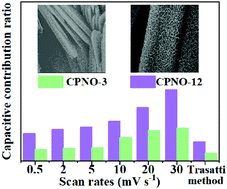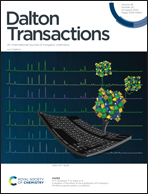Regulating the electrochemical behaviours of a hierarchically structured Co3(PO4)2/Ni–Co–O for a high-performance all-solid-state supercapacitor†
Abstract
Battery-type materials (e.g., transition metal phosphates) have been intensely explored in supercapacitors due to their rich electroactive sites and high theoretical capacity. Yet poor rate performance, resulting in a low energy density at high current density, limits their further applications. Herein, an improvement in rate performance resulting from enhanced surface capacitive behaviour contribution has been observed in a hierarchically structured Co3(PO4)2/Ni–Co–O@Ni foam (CPNO-12). The optimized CPNO-12 synthesized through a facile hydrothermal treatment also exhibits a striking gravimetric and areal capacity of 1410C g−1 (14 100 mC cm−2) at 5 mA cm−2 and superb cyclability (91% of retention at 50 mA cm−2 after 12 000 cycles), which can be attributed to its unique hierarchical porous structure and high mass loading per area. More importantly, a high-performance all-solid-state asymmetric supercapacitor with CPNO-12 and Fe2P/graphene hydrogel@Ni foam as positive and negative electrodes respectively has been assembled; the device delivering a maximum energy density of 95 W h kg−1 (32 mW h cm−3) and maximum power density of 4000 W kg−1 (800 mW cm−3) has the potential to power sophisticated systems. These attractive performances confirm that an enhancement of capacitive behaviour in battery-type materials holds the promise for fabricating high-performance supercapacitors.



 Please wait while we load your content...
Please wait while we load your content...